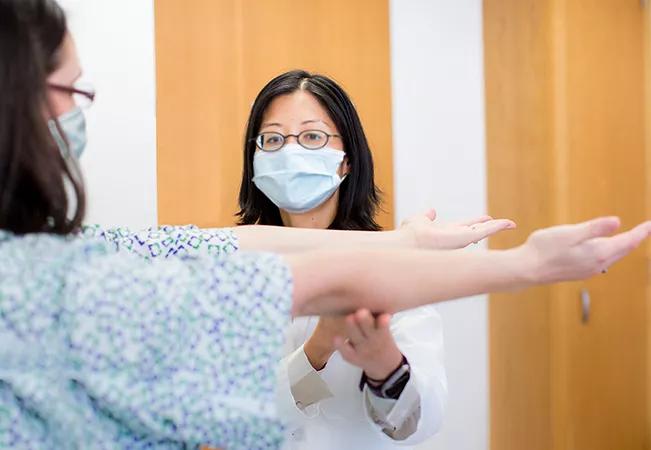PCPs reveal low levels of confidence in assessing for amyotrophic lateral sclerosis

The leading contributors to delayed diagnosis of amyotrophic lateral sclerosis (ALS) in the primary care setting are gaps in clinical knowledge and/or skills for detecting signs and symptoms along with delays in care-seeking by patients and in being able to access a neurologist or neuromuscular specialist upon referral. So concludes an email-based survey of primary care providers (PCPs) in various Ohio locations of the Cleveland Clinic health system.
Advertisement
Cleveland Clinic is a non-profit academic medical center. Advertising on our site helps support our mission. We do not endorse non-Cleveland Clinic products or services. Policy
“Studies indicate that ALS is typically diagnosed about one year after it could first be,” says John Morren, MD, a Cleveland Clinic neurologist and first author of the survey report, which was published in the Journal of the Neurological Sciences. He notes that patients generally benefit from earlier diagnosis, as it gives them more time to deal with the impacts of this terminal disease, from the logistics of medical care to preparations on financial, emotional and family fronts. Moreover, earlier enrollment of patients in clinical trials is likely to improve the prospects for a better response to investigational therapies.
Despite these advantages of earlier diagnosis, there is little published evidence on what leads to delay in ALS diagnosis, particularly in the context of primary care, where many patients first present. “We set out to determine factors that lead to delay in diagnosis at the PCP level and to identify ways to improve continuing medical education for PCPs to reduce such delays,” Dr. Morren explains.
He and his co-investigators conducted an email survey of PCPs at various Ohio locations in the Cleveland Clinic health system in November 2019. No existing surveys for this purpose were available, so they developed a de novo survey instrument informed by published data on factors relating to ALS diagnostic delay relevant to the primary care setting. The survey was reviewed and refined by a groups of U.S. experts in ALS and neuromuscular disease.
Survey questions addressed respondents’ medical knowledge of ALS, knowledge and practice of neurologic evaluation, practices for patient follow-up, and habits and preferences for patient referral; additional questions assessed interest in relevant educational materials on ALS.
Advertisement
The survey was emailed to physicians and advanced practice providers (APPs; specifically, certified nurse practitioners and physician assistants) in internal, family, hospital and geriatric medicine. Response rates were 12% among physicians (47/404) and 10% among APPs (30/287).
Survey results showed low degrees of confidence among respondents in several key areas of ALS evaluation:
Despite these low confidence levels, a large majority of respondents correctly identified appropriate (versus sham) signs and symptoms that should prompt suspicion for ALS, although a third or less correctly identified cognitive/behavioral changes, emotional lability or muscle cramps.
“This is an important knowledge gap,” Dr. Morren observes, “as nearly half of all ALS patients have frontotemporal cognitive dysfunction to some extent, and nearly the same proportion will develop pseudobulbar affect, including involuntary inappropriate laughter or crying.”
The investigations that respondents said they would most often consider when assessing a patient with progressive muscle weakness of indeterminate cause were electrodiagnostic testing, brain MRI, serum creatine kinase level, and MRI of the cervical or thoracic spine. “This is encouraging, as these are the appropriate diagnostic tests in this setting,” Dr. Morren notes.
Advertisement
Overall, more than 80% of respondents said they would always or “most of the time” refer a patient with progressive muscle weakness of indeterminate cause, most frequently to a general neurologist or a neuromuscular specialist. However, about one-third of respondents said they had some reservations about referral, predominantly due to long wait times for scheduling appointments with a specialist.
In fact, long patient wait times for a specialist appointment was the third most common cause for ALS diagnostic delay cited by respondents, after patient delays in seeking care and diagnostic uncertainty.
The study authors note that although their findings are limited by a small sample size of PCPs in a single state and health system, there was general consistency in findings between physician and APP respondents, and the results are generally consistent with previously published non-survey data about knowledge of ALS among PCPs.
“There are substantial patient benefits to be gained from earlier diagnosis of ALS,” says Dr. Morren. “While these data underscore the importance of finding ways to expedite access to neurologists upon PCP referral, they also identify opportunities to address some of the diagnostic uncertainties among PCPs that can contribute to diagnostic delay. Most survey respondents indicated interest in educational interventions targeting their knowledge and skills gaps around evaluation for ALS. We hope these findings can be used to shape future continuing education offerings in this area.”
Advertisement
Advertisement

Modest research progress to date can still be turned into meaningful patient gains

As genetic insights refine diagnosis, research abounds on current and emerging therapies

Advances in imaging technology could offer new insights for combatting age-related muscle loss

Genetic testing at Cleveland Clinic provided patient with an updated diagnosis

Findings show profound muscle loss variance between men and women

In rehabilitation medicine, the answer might require nuance

Large NIH-funded investigation is exploring this understudied phenomenon

Advances in genomics, spinal fluid analysis, wearable-based patient monitoring and more